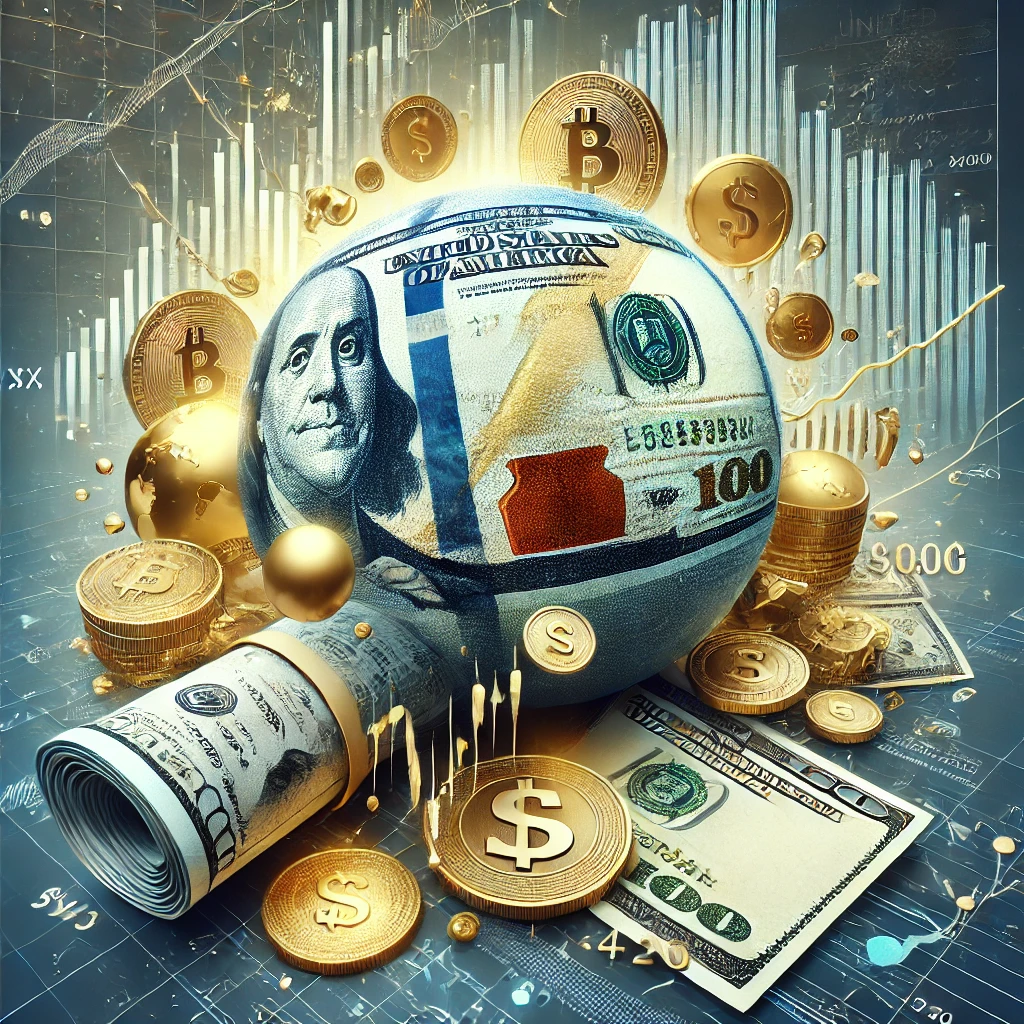The United States Dollar (USD) is one of the most influential and widely used currencies in the world. As the official currency of the United States, it serves as the backbone of the global financial system. The USD is not only the primary medium of exchange in the U.S. but also plays a significant role in international trade, investments, and reserves held by central banks. Due to its stability and strength, many countries either peg their currencies to the U.S. dollar or use it as an official or de facto currency.

Maxforce Fusion 30 gm Cockroach Gel for Home and Kitchen | Anti Roach Gel | Cockroach Killer | Home Pest Control
Price: ₹569
The U.S. dollar has a rich history, dating back to the late 18th century. Over time, it has evolved from simple paper notes to highly secure digital transactions, reflecting advancements in technology and finance. Today, the Federal Reserve, which acts as the central banking system of the United States, regulates the circulation and value of the dollar, ensuring economic stability.
With an immense global influence, the USD dominates foreign exchange markets, serving as the world’s primary reserve currency. This dominance stems from factors such as the size of the U.S. economy, the trust in U.S. institutions, and its role in international trade. The petrodollar system, for instance, reinforces the dollar’s supremacy by requiring oil transactions to be conducted in USD.
The demand for the USD extends beyond American borders, making it a preferred currency for transactions, savings, and investments worldwide. Given its significance, understanding the history, impact, and future of the U.S. dollar is crucial for businesses, policymakers, and individuals alike.
Table of Contents
Origin and Implementation of the U.S. Dollar
The Role of the U.S. Dollar in Global Finance.
Security Features of the U.S. Dollar
Top 10 Exclusive Facts About the U.S. Dollar
Origin and Implementation of the U.S. Dollar
The idea of the U.S. dollar as a national currency arose from the need for economic stability and uniformity among the newly independent American states. Before its creation, the American colonies used a mix of foreign currencies, including the Spanish dollar, British pounds, and Dutch guilders. The lack of a standardized currency led to economic inefficiencies and difficulties in trade.
The Founding Fathers, particularly Alexander Hamilton and Thomas Jefferson, recognized the importance of a national currency for economic growth and sovereignty. Inspired by the Spanish dollar, which was widely used in the Americas, the U.S. government sought to create a stable and reliable currency.
The idea materialized with the passage of the Coinage Act of 1792, which officially established the United States Dollar as the nation’s currency. The act created the U.S. Mint and defined the dollar’s value based on a bimetallic standard, linking it to both gold and silver. The first U.S. coins were minted in 1794, providing a tangible and official medium of exchange.

For much of the 19th century, paper money was issued by individual banks, leading to inconsistencies and counterfeiting. To resolve this, the National Banking Act of 1863 was passed, standardizing the issuance of banknotes. During the Civil War, the government introduced the first federally-issued paper currency, known as greenbacks, to finance war expenses.
The establishment of the Federal Reserve in 1913 marked a major shift in the monetary system. It centralized the control of currency issuance, improving monetary policy and economic stability. Later, in 1971, President Richard Nixon detached the dollar from the gold standard, transforming it into a fiat currency, where its value was determined by market forces rather than a fixed amount of gold.
The implementation of the U.S. dollar as a national and global currency was driven by necessity, economic strategy, and regulatory frameworks. Over time, the dollar evolved into the world’s primary reserve currency, shaping international trade and finance.
History of the U.S. Dollar
The U.S. dollar’s journey began in 1792 with the passing of the Coinage Act, which established the dollar as the country’s official currency. The early dollar was inspired by the Spanish dollar, which was widely circulated in the Americas at the time. The first U.S. banknotes were issued in the 1860s to finance the Civil War. Before this, transactions were mainly carried out using gold and silver coins.
The creation of the Federal Reserve System in 1913 was a turning point for the U.S. dollar, as it centralized control over monetary policy. Over the years, the dollar transitioned from the gold standard to a fiat currency in 1971, when President Richard Nixon ended the dollar’s convertibility into gold, known as the Nixon Shock.
The Role of the U.S. Dollar in Global Finance
The U.S. dollar is the most widely used currency in the world for trade, investments, and reserves. It accounts for a majority of foreign exchange transactions and is the dominant currency in commodities trading, including oil and gold. The International Monetary Fund (IMF) reports that more than 60% of global foreign exchange reserves are held in USD, making it a cornerstone of global finance.
Due to its reliability, many nations either peg their currency to the USD or adopt it as their official currency. Countries like Ecuador, El Salvador, and Panama use the U.S. dollar as their official legal tender, ensuring economic stability and reducing inflation risks.
Security Features of the U.S. Dollar
The U.S. dollar is equipped with numerous security features to prevent counterfeiting. These include color-shifting ink, watermarks, security threads, and microprinting. The $100 bill, for example, incorporates a 3D security ribbon and a bell in the inkwell that changes color when tilted.
As of February 2025, the U.S. dollar (USD) continues to play a dominant role in global finance, accounting for a significant share of international payments. According to data from the Society for Worldwide Interbank Financial Telecommunication (SWIFT), the USD remains the most used currency for international payments as of September 2024.

However, recent developments have influenced the USD’s exchange rates against various currencies. For instance, the announcement of new tariffs by the U.S. administration led to a decline in the dollar’s value, while the Indian rupee (INR) experienced a slight appreciation.
Below is a comparison of exchange rates of selected major currencies against the Indian Rupee as of February 14, 2025:
| Currency | Currency Code | Exchange Rate (1 Unit to INR) |
| United States Dollar | USD | 86.85 |
| Euro | EUR | 95.20 |
| British Pound | GBP | 110.75 |
| Japanese Yen | JPY | 0.65 |
| Australian Dollar | AUD | 62.30 |
| Canadian Dollar | CAD | 68.40 |
| Swiss Franc | CHF | 98.50 |
| Chinese Yuan | CNY | 13.50 |
| Singapore Dollar | SGD | 64.20 |
| South Korean Won | KRW | 0.075 |
Note: The exchange rates are indicative and sourced from market data as of February 14, 2025.
In conclusion, while the U.S. dollar remains a cornerstone of international finance, its value relative to other currencies, including the Indian rupee, is subject to fluctuations influenced by global economic policies and market dynamics.
The Future of the U.S. Dollar
With the rise of cryptocurrencies, digital payments, and central bank digital currencies (CBDCs), the future of the U.S. dollar is evolving. The Federal Reserve has been exploring the possibility of a digital dollar to keep pace with technological advancements and ensure the dollar’s relevance in a digital economy.
Despite emerging financial technologies, the U.S. dollar is expected to remain dominant due to its strong global presence, trust, and stability.
Top 10 Exclusive Facts About the U.S. Dollar
- The U.S. dollar is the most counterfeited currency – Due to its widespread use, counterfeiters often target the USD, leading to advanced security measures.
- Over $1.8 trillion USD is in circulation – This figure continues to grow as demand for cash remains strong.
- The $2 bill exists but is rare – The U.S. still prints $2 bills, but they are seldom seen in circulation.
- U.S. banknotes are made of cotton and linen – Unlike regular paper, U.S. bills are composed of a cotton-linen blend, making them more durable.
- The first paper dollar was printed in 1862 – It was introduced as a response to the Civil War’s financial demands.
- All U.S. bills feature dead presidents – Except for Alexander Hamilton ($10 bill) and Benjamin Franklin ($100 bill), every U.S. bill displays a former president.
- The Great Seal of the United States is on the $1 bill – It features a pyramid with an eye, symbolizing strength and vigilance.
- More than 60% of all USD bills are outside the U.S. – Many foreign governments and businesses hold USD as part of their reserves.
- The U.S. dollar sign ($) originated from the Spanish peso – The modern dollar sign is derived from the abbreviation for the Spanish peso.
- The Federal Reserve controls the money supply – The Fed’s monetary policies influence inflation, employment, and economic growth.
Conclusion
The United States Dollar is much more than a simple medium of exchange; it is a pillar of global finance, trade, and economic stability. As the most widely used and trusted currency, the USD plays an essential role in international markets, banking systems, and government reserves. From its historical roots in the Coinage Act of 1792 to its modern role in the digital economy, the dollar has consistently evolved to meet the needs of a changing world.

Its global dominance is not solely based on its widespread use but also on the economic and political stability of the United States. The Federal Reserve’s policies play a crucial role in maintaining its value, ensuring that it remains a reliable currency for investors, businesses, and governments worldwide. The petrodollar system further cements its position, as oil transactions are primarily conducted in USD, reinforcing demand for the currency.
Security is another key aspect of the U.S. dollar’s longevity. Advanced countermeasures, including color-shifting ink, security threads, and holograms, help prevent counterfeiting, maintaining trust in the currency. As technology advances, the introduction of digital dollars and blockchain-backed transactions may further enhance security and efficiency, ensuring the dollar’s continued dominance.
Looking ahead, while digital assets like Bitcoin, stablecoins, and central bank digital currencies (CBDCs) are emerging, the U.S. dollar remains the preferred global currency. Its adaptability to economic shifts, combined with its long-standing credibility, ensures its relevance for decades to come. Whether in physical form or as a digital asset, the U.S. dollar will continue to be a symbol of financial strength, stability, and economic power.
Curated Reads




